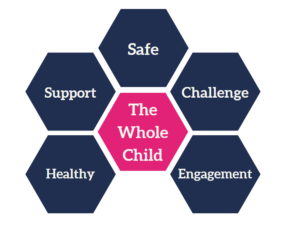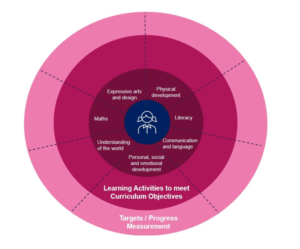There has been a lot of discussion over the last year about the SEND curriculum. However, it’s important to start with establishing what it is not. It is not an ‘off the shelf’ pre-packaged product that we can hand over to our teachers or teaching assistants to run with. It is not a one-size-fits-all curriculum for SEND, or groups of SEND learners, in our settings. It is not limited to the measures of progress offered through the National Curriculum.
The SEND curriculum focuses on the individual learner and uses the graduated response to build a curriculum that is personalised and meaningful to them.
The ASCD’s Whole Child approach provides a useful framework for developing an outstanding curriculum for SEND. It is based on the premise that a successful learner is:
knowledgeable, emotionally and physically healthy, civically inspired, engaged in the arts, prepared for work and economic self-sufficiency, and ready for the world beyond formal schooling.
There are five key areas to consider:

And in each of these we consider how our settings address the cognitive, physical, social and emotional needs of each learner to support inclusion in all aspects of school, family and community life.
The Curriculum Pathways
The introduction of the Engagement Model in September 2021 has caused some consternation in mainstream schools. It is important that we recognise that this is only for our most profound and complex learners who are not engaged in subject-specific study. These children and young people are also known as Pre-Formal Learners.
There are three other curriculum pathways that we need to consider for our learners with SEND:
- Semi-Formal Explorers
- Semi-Formal Challengers
- Formal Learners
Each pathway has a unique set of characteristics that will determine how we construct the curriculum for the individual. However, we must remember that depending on the profile of their strengths and needs, a learner may be on more than one pathway concurrently. This is best exemplified through the spiky profile of the autistic learner who may be accessing the National Curriculum in some subject-specific areas but may need a personalised curriculum which focuses on their core areas of difference e.g. social skills or learning through play.
Building the SEND Curriculum requires leaders to be flexible in their approach; we need to adapt the curriculum model to fit the needs of the learner rather than expecting the learner to fit our model. And while the Engagement Model has been designed for Pre-Formal Learners specifically, there is much to learn about curriculum design from the core principles that drive it. In essence, we should recognise where an individual shows high levels of engagement and use those motivators to build a curriculum that is meaningful for them.
A Strategy for SEND Curriculum Development
Stage 1: Assess
At the core of this stage in the process is co-production.. We work with learners, their families, teaching staff and any external professionals involved in meeting their needs to identify their strengths, motivators and needs.
The key questions are:
- What can they already do?
- Where have they already experienced success?
- What motivates them to engage with learning experiences?
- What do they need to do next?
Asking these questions with reference to the four main areas of SEND, the Whole Child approach and the curriculum pathways helps us to build a comprehensive picture of the learner and determine what we need to do to plan for inclusion.
Stage 2: Plan
The planning format below has been adapted from the Possible Lines of Development approach to curriculum planning, developed for EYFS by the Pen Green Centre.
Begin by identifying the key areas of focus of the personalised curriculum. In the example curriculum above, the learner will focus on maths, literacy, communication and language, personal, social and emotional development, their understanding of the world, physical development and expressive arts and design.
Our second task is to identify the learner’s targets and how progress will be assessed. Consider:
- What can the learner do now?
- What do they need to do next?
- How does this link to EHCP objectives, if they have one?
- How will we know that they have made progress?
- When will progress be reviewed?
Finally, we need to identify the learning activities that they will engage in. Consider:
- What learning activities will support the development of skills/knowledge?
- What will good progress look like?
- How will those activities build on the learner’s strengths, interests or motivators?
- How will you support development at home to generalise learning?
- What will happen if the learner is not making good progress?
Stage 3: Do
It is important that all adults involved in supporting the learner have shared ownership of the planned curriculum. It is also helpful to build into the plan regular opportunities for reflection.
Stage 4: Review
It is important that reviews are conducted with the learner and their family.

